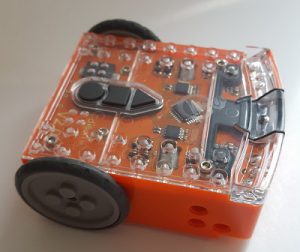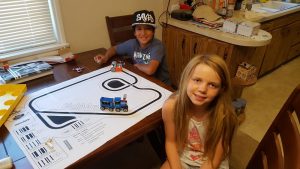
I am honing a few of my lost skill sets that went unused over the past twenty years or so while in the work force. My schooling in robotics from way back when shows little resemblance to the plethora of educational opportunities in robotics available today. Here is a STEM resource that would fit well in any class from elementary through high school.
One of my teacher friends recently mentioned that she teaches programming to her 4th grade class. Yikes! When I was in 4th grade I think I was still learning how to spell my name. Of course that would have been back when dinosaurs roamed the Earth. It makes sense though, because robotics is inevitably the future. Young people today may create and program a robot that will someday replace them in their robot creating and programming occupation. But let’s not get too pessimistic.
The robot I decided on is called Edison. Among the many reasons I choose Edison is its affordability, which includes lots of freebies from the website. A single Edison microbric costs about $50 and shipping is free. The cost goes down as you increase the size of the EdPack. You can get the 30 pack for less than $1000. The website includes lots of downloadable stuff like instructions sets, lesson plans for teachers, activity mats, and of course EdWare, the free programming software for Edison.
You can print the Activity Mat in black and white using a normal printer and nine sheets of paper. When printing the mat, use the following PDF printing settings:
- Zoom: Split pages to multiple sheets
- Check: Remove Margins
- Cut Marks: None
There will still be some trimming of margins and any lines can be filled in with a Sharpie. Be sure to tape the pages together using a matte or non-reflective tape so Edison’s sensors will not be blinded by the reflection.
Edison is Lego compatible and by adding more microbrics and Legos you can increase the complexity for your simple two wheeled vehicle and morph it into items such as a crane, backhoe or even a printer. I’m sure with some imagination, many other projects can be engineered.
So I got my Edison, made a mat and invited Caitlin and Manny over for some testing. Edison worked perfectly right out of the box. My little scientists ran Edison through its paces in each of the pre-programmed bar code adventures.

Our next adventure with Edison will be to do some programming using EdWare, the free download for Windows and several other operating systems. It also comes in an online version. EdWare uses modular or block programming and allows the student to drag and drop blocks of code. Some examples of block programming are: Blockly, Snap, and Scratch. All are great tools for introducing novice programmers to the world of coding.
When your students are ready to move from the graphical blocks of code to the more complicated text coding, they can use EdPy, the online coding environment for Edison that uses a version of Python, one of the more popular programming languages around today.
As a fun project for your class, you could have Edison robot wars using another function that Edison is capable of. Edison can be programmed using four bar codes for turning left and right and moving forward and backward by using a TV remote control. The students could decorate their Edisons with some Lego bricks, for aesthetic value only and fight each other using a circle on the floor. The object would be for one robot to move the other out of the circle like a Sumo wrestler.
Edison is a great robotics and programming teaching tool. It is used in many STEM programs worldwide. Teaching robotics and programming also teaches young people about problem solving, logical thinking, math ideas, algorithms, and a myriad of other concepts that can be beneficial in our increasingly technological world.